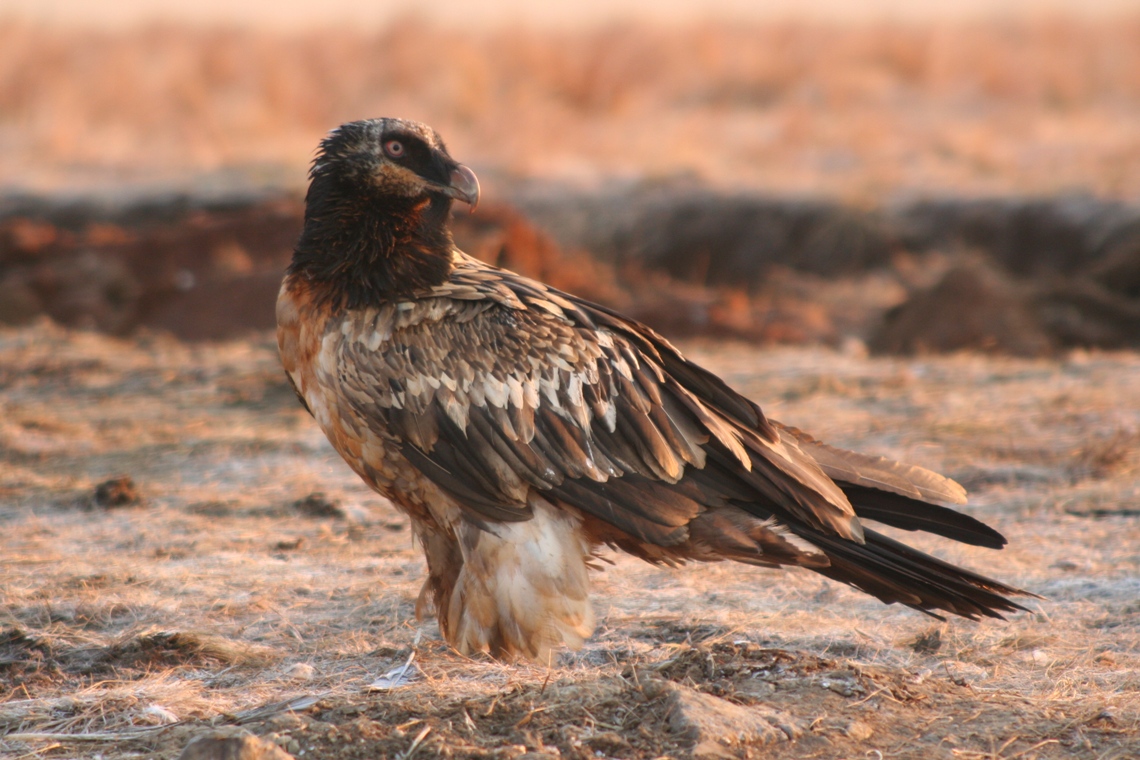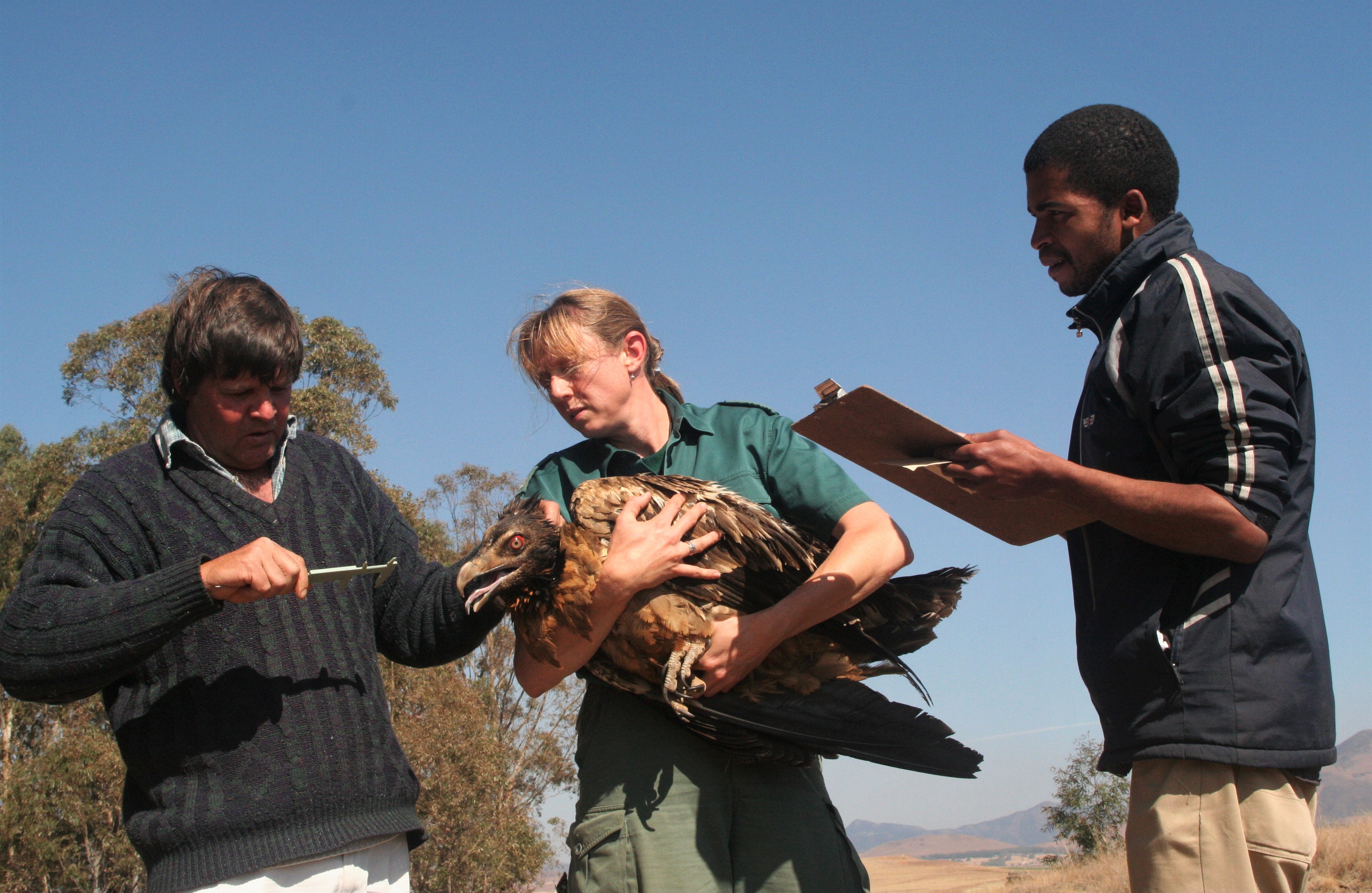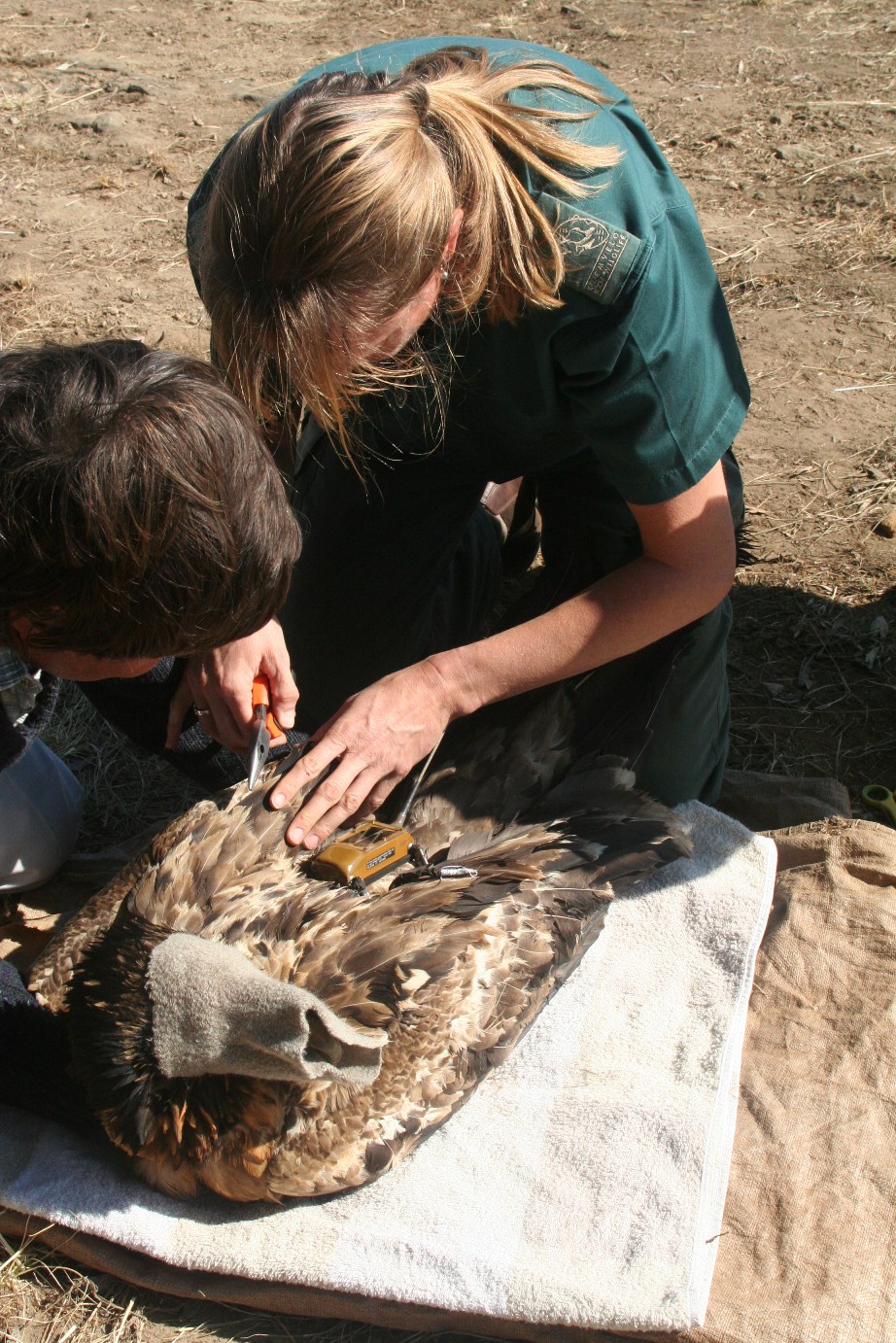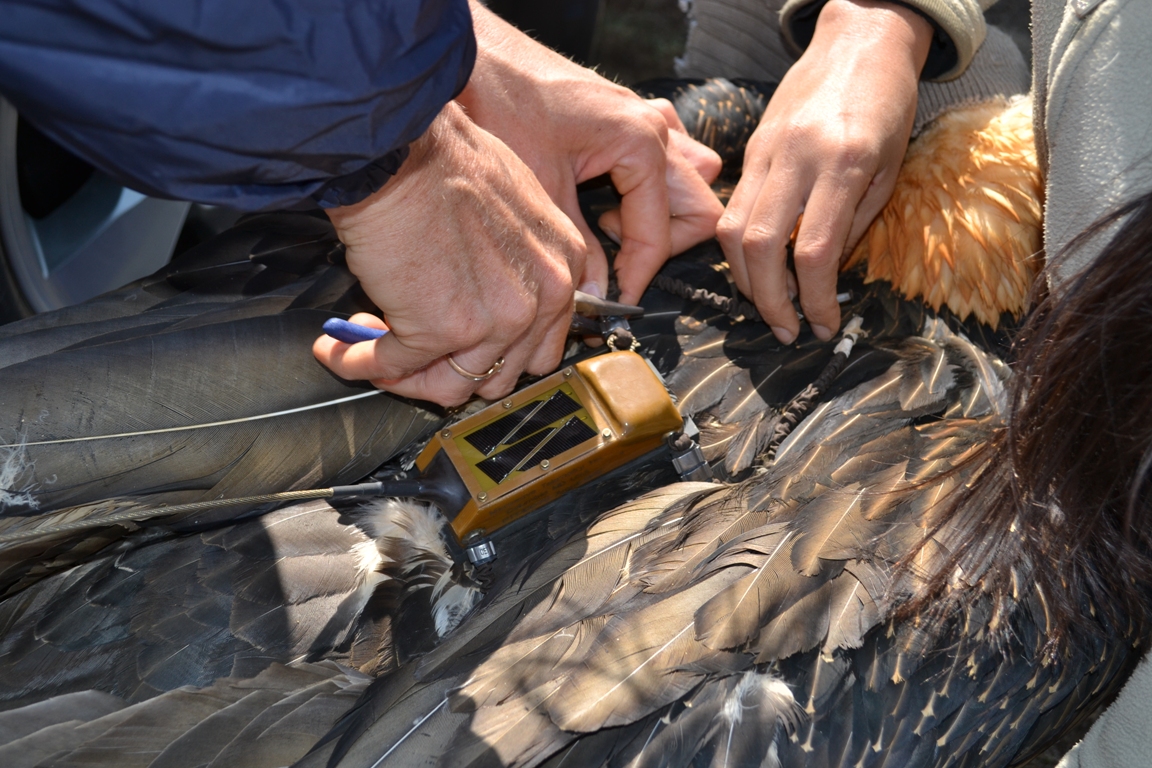- Vultures in southern Africa are being killed, mainly by eating carcasses poisoned by farmers, and in collisions with power lines and wind turbines.
- Concerned about population declines, the Maloti-Drakensberg Vulture Project began tracking vulture movements with small GPS transmitters, only to find them dying at a rapid rate.
- The three-dimensional tracking data showing the overlap between vulture breeding and roosting areas resulted in cancellation of a pair of proposed wind farms in Lesotho and a call for more ecologically informed siting of needed renewable energy infrastructure.
CAPE TOWN, South Africa — Every other hour, Sonja Krüger logs onto her website and checks the birds’ status. Pharoah is taking a mud bath in the mountains, Jeremia is on a roost site viewing the Maloti mountain range, and Mollie is scouring the grasslands for a fresh carcass.
“A GPS location of the birds is taken very hour, and it shows where the vultures are flying to, at what speed, their favorite cliff roost sites, and where they feed,” Krüger, an ecologist with the NGO Ezemvelo KZN Wildlife, told Mongabay.
Data have told us a lot about these birds’ movement and population trends, she added.
Ezemvelo runs Maloti-Drakensberg Park, a World Heritage Site within the mountain range of the same name. The range is home to vultures in Lesotho and the provinces of KwaZulu-Natal, Eastern Cape and Free State in South Africa.

The isolated southern African population of bearded vultures (Gypaetus barbatus meridionalis) has declined by more than 30 percent over the past few decades, with fewer than 350 individual birds and 109 breeding pairs remaining in the region.
Cape vultures (Gyps coprotheres), found only in southern Africa, are endangered, with 2,900 breeding pairs. Approximately 1,450 individuals, roughly 20 percent of the population, live in the Maloti-Drakensberg mountains.
The roll call
In 2006, Krüger started the Maloti-Drakensberg Vulture Project to address the decline in vulture populations within the mountains. She said the vultures feasted on carcasses and thus kept the environment clean, so a decline in numbers was a huge loss for the ecosystem.
With support from several environmental institutions, including Ezemvelo KZN Wildlife, the Maloti-Drakensberg Transfrontier Programme, Wildlands Conservation Trust, and the Endangered Wildlife Trust, the project began tracking the birds’ movements and habits.
“Catching the vultures was not easy,” Krüger said. “It was challenging, but rewarding.”

The project tracked 25 bearded vultures and a few Cape vultures, of both sexes and various age groups, by designing and fitting miniature backpack harnesses for the birds to carry satellite GPS transmitters. It also used the tags to assess the birds’ survival rates and causes of mortality to assist efforts to recover the populations and build awareness of the importance of vultures in ecological systems.
“Numbers were declining, and we wanted to know what was causing the mortality of the vultures,” Krüger said. “We sought a better idea of where the vultures move, and [wanted to] get a full ranging territory, providing data on feeding and breeding sites.”
Ben Hoffman, a falconer based in Durban, in KwaZulu-Natal province, fitted the transmitters. Two years earlier, he had started Raptor Rescue, providing specialist treatment to injured, sick, and orphaned birds of prey.
“I have used radio trackers on my birds when I flew them for many years,” he said, “so I had some experience in the field of tracking raptors.”
The transmitter on each 6- to 11-kilogram (13- to 24-pound) bird costs $3,000 and is powered by a tiny, lightweight solar panel, with a combined weight of about 70 grams (2.5 ounces). The transmitter relays a bird’s location data hourly between 5 a.m. and 8 p.m. through the Argos satellite network to a website where Krüger accesses the data. The researchers pay $68 per vulture monthly for data processing.

The transmitters have been sending back data on the birds’ movements for the past decade, longer than the maximum seven-year life span specified by Microwave Telemetry, the U.S. manufacturer of the satellite trackers.
Some vultures, however, started falling off the radar only a few months after their trackers were fitted. Krüger and her team went to investigate.
They found them dead, often in very inaccessible locations on commercial farms, communal land, and even in protected areas. The main cause of death was poisoning from lead and agricultural chemicals.
“Farmers trying to protect their sheep or cattle from being attacked by jackals often laced carcasses of dead animals with poison,” Krüger said. “Vultures ate poisoned carcasses and were found a distance away from the feeding spots.”
In one particularly severe incident, more than 50 Cape vultures and a jackal were found dead near a sheep carcass on a farm. “This was a clear case,” Krüger said, “and [the perpetrator] was prosecuted.”

Only six of the original 25 tagged vultures survive. One died from a power-line collision, nine were poisoned, and another was shot. One was found dead as recently as this past November; tests have not yet confirmed the cause of death.
Vultures were also used for traditional medicine, Krüger said. “Vulture body parts are believed to be potent for enabling psychic abilities, foresight, and increased intelligence.” Since numbers of all vultures in southern Africa were on the decline, any use of these birds was unsustainable, she added.
The raptors’ survival is also threatened by electrocution on poorly designed power poles and collisions with electrical cables and, more recently, wind turbines.
Controversial Lesotho wind power
In 2012, the government of the landlocked kingdom of Lesotho approved wind farm operations in the country’s northeast, proposed by PowerNET Development. This first-ever large-scale development of two wind farms in Lesotho, consisting of 42 and 100 turbines, respectively, was controversial. The site lay within the breeding, roosting, and foraging grounds of important populations of both bearded and Cape vultures.
The company planned to set up multiple wind farms throughout the Lesotho highlands, ultimately aiming to produce about 6,000 megawatts from up to 4,000 turbines.
In 2014, Ken Mwathe, then BirdLife International’s Africa policy program coordinator, warned in a statement that African governments needed to approach renewable energy projects carefully to ensure they did not threaten birds and biodiversity.

The wind farm developer proposed mitigation measures, including the use of radar linked to a system that would automatically shut turbines down when birds were at risk of colliding. But the impact assessment’s avifaunal report indicated that the project would have severe negative effects on vultures and other sensitive bird groups, even with mitigation.
The project would not be feasible if these measures were implemented, said Samantha Ralston, birds and renewable energy manager at BirdLife South Africa, because wind turbines would not generate electricity when not turning.
Ralston said the conservation community lacked sufficient information to know whether proposed mitigation measures would be effective in substantially reducing the risk to the vultures. She called for more research to understand “how often, at what height and under what conditions the birds move through the site.”
An application of tracking data
The outcomes of Krüger’s team’s research then became handy.
A study using data from 2009 to 2013 of the three-dimensional movements of 21 of the 25 bearded vultures fitted with the solar-powered GPS tags was published in 2015.
“We used data collected in Lesotho and South Africa to create [collision] risk models,” said raptor biologist and co-author Arjun Amar, of the FitzPatrick Institute of African Ornithology at the University of Cape Town. “The models were further refined by incorporating flying heights at risk of collision to predict areas prone to impact with wind turbines.”
The transmitters generated data, logging the vultures’ location, altitude, and speed every hour during daylight, allowing the team to develop different models for birds of different ages.

The sites proposed for the two wind farms were in areas heavily used by vultures and therefore likely to damage the vulture population through collisions, the study concluded. “Altitudes of fixes of adults and non-adults,” the authors said in their paper, “showed that they spent 55 percent and 66 percent of their time, respectively, at heights that placed them at risk of collision.”
“We did not want to stand in the way of development,” Amar told Mongabay. “Our aim was to produce maps that could be used to promote sustainable development.”
The wind energy developers and financiers backing the wind farm cancelled their project. Four years later, in early 2018, the U.K.-based firm AGR-Renewables resurrected the project.
“We have delivered a number of wind and solar energy projects in the UK over the last years, all in line with the environmental standards required under the UK planning system,” Tom Forsyth of AGR-Renewables told The Star, a South African newspaper, in February 2018.
The company was aware of the concerns raised about the project, Forsyth added, and it had employed a team of bird specialists to carry out “an intensive programme of bird monitoring — something that has hitherto not been carried out … to evaluate the potential impact of the project and the suitability or otherwise of the site to accommodate the proposed wind farm,” he told The Star.

In the end, the new developer also withdrew from the project, Krüger said. “They took heed of our concerns.”
Krüger’s team still tracks four bearded and two Cape vultures from the original group, and she checks on them regularly.
“The design of the project has managed to get excellent results,” Krüger said, adding the technology has been adapted for tracking other bird species, including hornbills.
FEEDBACK: Use this form to send a message to the editor of this post. If you want to post a public comment, you can do that at the bottom of the page.